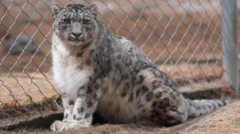In a groundbreaking initiative in Gilgit-Baltistan, conservationists are testing AI-driven cameras designed to detect snow leopards and alert farmers via text messages to safeguard their livestock. With a rapid decline in snow leopard populations attributed to retaliatory killings, this innovative approach seeks to strike a balance between wildlife conservation and local livelihood.
Utilizing AI to Protect Snow Leopards: A Breakthrough in Conservation Efforts

Utilizing AI to Protect Snow Leopards: A Breakthrough in Conservation Efforts
New AI-powered camera technology aims to alert villagers about snow leopard presence, potentially reducing human-wildlife conflict and aiding in conservation efforts.
In the rugged terrain of Pakistan-administered Gilgit-Baltistan, conservationists are fighting against the clock to protect the dwindling population of snow leopards. Known for their elusive nature and striking beauty, these majestic creatures are under threat, with estimates suggesting that only 4,000 to 6,000 remain in the wild. The World Wide Fund for Nature (WWF) reports that between 221 and 450 of these endangered animals are killed each year, primarily in retaliation for livestock losses.
One particularly poignant story is that of “Lovely,” a snow leopard orphaned as a cub and now unable to survive in the wild after years of being cared for by humans. Her case highlights the dilemma of managing human-wildlife conflicts in an area where these majestic predators have been known to attack livestock, leading to fatal reprisals from farmers.
In a bid to mitigate these conflicts, WWF, in collaboration with Lahore University of Management Sciences (LUMS), is pioneering an ambitious project employing artificial intelligence (AI) to monitor snow leopards' movements. The project utilizes specially designed cameras equipped with AI software capable of distinguishing between animals, humans, and the snow leopards themselves. These cameras are strategically placed across several villages and powered by lithium batteries and solar panels to function in the challenging mountainous terrain.
As the cameras gather data, they send alerts to local farmers via text messages, advising them to relocate their livestock when snow leopards are detected in proximity. Conservationist Asif Iqbal expresses cautious optimism about the technology's potential effectiveness, citing successful recordings of snow leopards in recent weeks.
Despite the promise of AI, the implementation of this technology has not been without its challenges. Initial skepticism from local communities presented significant hurdles, and there have been instances of tampering with camera equipment. Additionally, in certain villages, adherence to privacy and cultural sensitivities hampers the consent process required to fully deploy this solution.
Village farmers like Sitara have experienced devastating losses due to snow leopard predation, with one recounting how an attack wiped out her entire flock of sheep. While she acknowledges the technology’s potential, she raises concerns about the reliability of mobile service in her remote area, casting doubt on the effectiveness of receiving alerts.
Though awareness about the ecological significance of snow leopards is gradually improving, many villagers remain unconvinced about their benefits, especially with climate change forcing them to adapt their grazing patterns, often putting their livestock in increased danger. WWF recognizes that their AI initiative cannot stand alone; legal measures against poaching and additional deterrents like visual and auditory cues are also under consideration to reduce human-wildlife conflict.
As conservationists continue to explore multi-faceted solutions, the heart of their work lies in understanding the complex relationship between humans and the wildlife they coexist with. The struggle to protect these "ghosts of the mountains," as snow leopards are often called, is far from over, but innovative approaches like AI technology show promise in creating a sustainable future for both villagers and the invaluable wildlife that inhabit their lands.





















